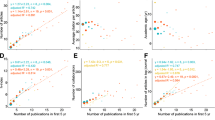Abstract
Although the use of bibliometric indicators for evaluations in science is becoming more and more ubiquitous, little is known about how future publication success can be predicted from past publication success. Here, we investigated how the post-2000 publication success of 85 researchers in oncology could be predicted from their previous publication record. Our main findings are: (i) Rates of past achievement were better predictors than measures of cumulative achievement. (ii) A combination of authors’ past productivity and the past citation rate of their average paper was most successful in predicting future publication success (R 2 ≈ 0.60). (iii) This combination of traditional bibliographic indicators clearly outperformed predictions based on the rate of the h index (R 2 between 0.37 and 0.52). We discuss implications of our findings for views on creativity and for science evaluation.

Similar content being viewed by others
Notes
Interestingly, one of our reviewers pointed out that our logarithmic prediction models have the same form as the Cobb–Douglas production function, which models how labour and capital can substitute each other to achieve a particular production goal.
References
Alonso, S., Cabrerizo, F. J., Herrera-Viedema, E., & Herrera, F. (2009). H index: A review focused in its variants, computation and standardisation for different scientific fields. Journal of Informetrics, 3, 273–289.
Bornmann, L. (2011). Mimicry in science? Scientometrics, 86, 173–177.
Bornmann, L., & Daniel, H.-D. (2005). Does the h index for ranking of scientists really work? Scientometrics, 65, 391–392.
Bornmann, L., & Daniel, H.-D. (2009). The state of h index research. EMBO Reports, 10, 2–6.
Bornmann, L., Mutz, R., & Daniel, H.-D. (2008a). Are there better indices for evaluation purposes than the h index? A comparison of nine different variants of the h index using data from biomedicine. Journal of the American Society for Information Science and Technology, 59, 830–837.
Bornmann, L., Wallon, G., & Ledin, A. (2008b). Is the h index related to (standard) bibliometric measures and to the assessments by peers? An investigation of the h index by using molecular life sciences data. Research Evaluation, 17, 149–156.
Bornmann, L., Mutz, R., & Daniel, H.-D. (2009). Do we need the h index and its variants in addition to standard bibliometric measures? Journal of the American Society for Information Science and Technology, 60, 1286–1289.
Dawes, R. M. (1979). The robust beauty of improper linear models in decision making. American Psychologist, 34, 571–582.
Dawes, R. M., Faust, D., & Meehl, P. E. (1989). Clinical versus actuarial judgement. Science, 243, 1668–1674.
Egghe, L. (2005). Power laws in the information production process: Lotkaian informetrics. Kidlington: Elsevier Academic Press.
Feist, G. J. (1993). A structural model of scientific eminence. Psychological Science, 4, 366–371.
Henzinger, M., Suñol, J., & Weber, I. (2010). The stability of the h index. Scientometrics, 84, 465–479.
Hirsch, J. E. (2005). An index to quantify an individual’s scientific research output. Proceedings of the National Academy of Science, 102, 16569–16572.
Hirsch, J. E. (2007). Does the h index have predictive power? Proceedings of the National Academy of Science, 104, 19193–19198.
Hönekopp, J., & Kleber, J. (2008). Sometimes the impact factor outshines the h index. Retrovirology, 5 (88).
Huber, J. C. (2001). A new method for analysing scientific productivity. Journal of the American Society for Information Science and Technology, 52, 1089–1099.
Jin, B., Liang, L., Rousseau, R., & Egghe, L. (2007). The R- and AR-indices: Complementing the h index. Chinese Science Bulletin, 52, 855–863.
Kelly, C. D., & Jennions, M. D. (2006). The h index and carrier assessment by numbers. Trends in Ecology and Evolution, 21, 167–170.
Lawrence, P. A. (2007). The mismeasurement of science. Current Biology, 17, R583.
Lehmann, S., Jackson, A. D., & Lautrup, B. E. (2008). A quantitative analysis of indicators of scientific performance. Scientometrics, 76, 369–390.
Lovegrove, B. G., & Johnson, S. D. (2008). Assessment of research performance in biology: How well do peer review and bibliometry correlate. BioScience, 58, 160–164.
Macilwain, C. (2010). Wild goose chase. Nature, 463, 291.
Poynard, T., Thabut, D., Munteanu, M., Ratziu, V., Benhamou, Y., & Deckmyn, O. (2010). Hirsch index and truth survival in clinical research. PLoS ONE, 5, e12044.
Redner, S. (1998). How popular is your paper? An empirical study of the citation distribution. The European Physical Journal B, 4, 131–134.
Schmidt, F. L., & Hunter, J. E. (1998). The validity and utility of selection methods in personnel psychology: Practical and theoretical implications of 85 years of research findings. Psychological Bulletin, 124, 262–274.
Schreiber, M. (2008). To share the fame in a fair way, h m modifies h for multi-authored manuscripts. New Journal of Physics, 10, 040201.
Simonton, D. K. (1997). Creative productivity: A predictive and explanatory model of career trajectories and landmarks. Psychological Review, 104, 66–89.
Simonton, D. K. (2003). Scientific creativity as constrained stochastic behaviour: The integration of product, person and process perspectives. Psychological Bulletin, 129, 475–494.
van Raan, A. F. J. (2004). Measuring science. Capita selecta of current main issues. In H. F. Moed, W. Glänzel, & U. Schmoch (Eds.), Handbook of quantitative science and technology research, pp. 19–50. Dordrecht: Kluwer Academic Publishers.
van Raan, A. F. J. (2006). Comparison of the Hirsch index with standard bibliometric indicators and with peer judgment for 147 chemistry research groups. Scientometrics, 67, 491–502.
Author information
Authors and Affiliations
Corresponding author
Rights and permissions
About this article
Cite this article
Hönekopp, J., Khan, J. Future publication success in science is better predicted by traditional measures than by the h index. Scientometrics 90, 843–853 (2012). https://doi.org/10.1007/s11192-011-0551-2
Received:
Published:
Issue Date:
DOI: https://doi.org/10.1007/s11192-011-0551-2




